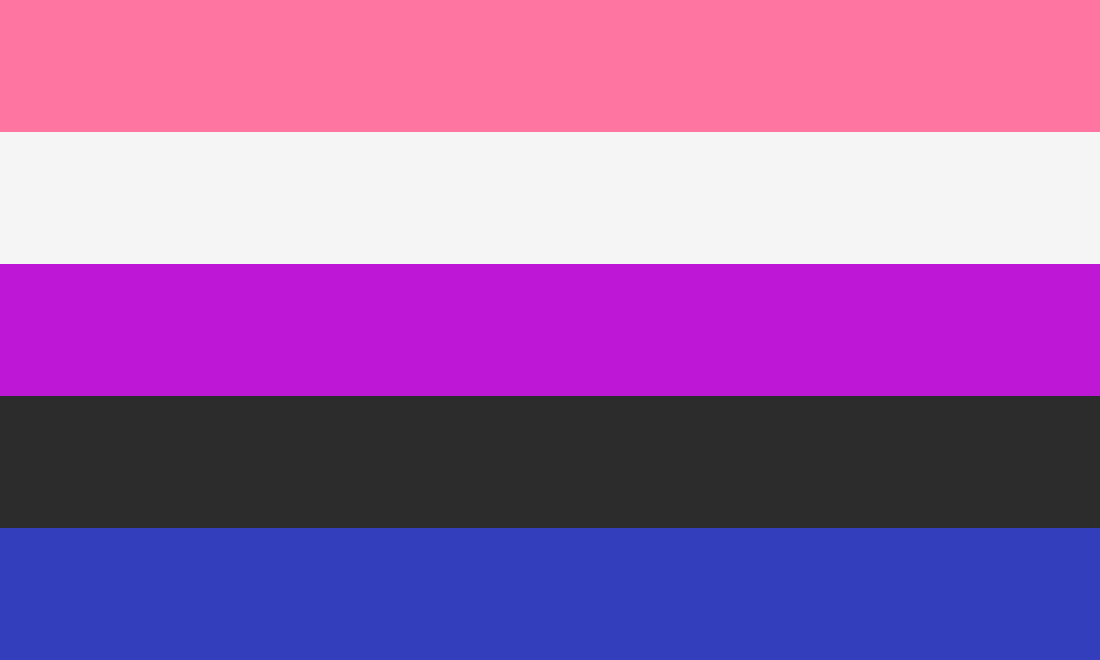Gender fluidity
Non-fixed gender identity From Wikipedia, the free encyclopedia
Gender fluidity (commonly referred to as genderfluid) is a non-fixed gender identity that shifts over time or depending on the situation. These fluctuations can occur at the level of gender identity or gender expression. A genderfluid person may fluctuate among different gender expressions over their lifetime, or express multiple aspects of various gender markers simultaneously.[1][2] Genderfluid individuals may identify as non-binary or transgender, or cisgender (meaning they identify with the gender associated with their sex assigned at birth).[3][4]
 The genderfluid pride flag | |
| Classification | Gender identity |
|---|---|
| Abbreviations | GF |
| Parent category | Non-binary |
| Symbol | or |
Gender fluidity is different from gender-questioning, a process in which people explore their gender in order to find their true gender identity and adjust their gender expression accordingly.[5] Gender fluidity continues throughout lives of genderfluid people.[6]
History
Summarize
Perspective
Transgender people (including non-binary and third gender people) have existed in cultures worldwide since the pre-colonial era. One example is the existence of gender fluidity in many Indigenous communities. Although the earliest records of gender fluidity in Indigenous communities was written by those who colonized them,[7] current research shows that over 150 pre-colonial groups are known to recognize or have historically recognized more than two genders.[8]
The Navajo people are one group who historically recognized between four and five gender identities, one of them being nàdleehi ('changing one' in English).[8] In more recent history, two-spirit has been an identity adopted by Indigenous gender and sexual minorities.[9] The term challenges binary categories of sex and gender and enables some Indigenous people to reclaim traditional roles within their societies.[9] According to the 2012 Risk and Resilience study of Bisexual Mental Health, "the most common identities reported by transgender Aboriginal participants were two-spirit, genderqueer, and bigender."[9]
The term Hijras is a historically recognized third gender within South Asian countries: Bangladesh, India, Nepal, and Pakistan. The term Hijras can date back to holy Hindu texts such as the Ramayana and the Mahabharata, where a Hindu character named Arjuna transforms into the third gender.[10] In South Asia, many Muslim rulers from the 15th to 19th century Mughal Empire were considered third-gender Indians.[10] Hijras are often assigned male at both, and adopt feminine characters, like clothing, grooming, and even use feminine names.[11]
Another example of historical recognition of gender fluidity is the Philippines. In the Philippines, they use the umbrella term baklâ to refer to "those born male who currently exist with a feminine gender expression."[8] Although this definition of the term is most common, there are a variety of identities that exist within the baklâ umbrella.[8]
Impact of Colonization
European colonization strictly enforced the binary gender concept onto many groups, including those mentioned above.[7][8] In the 1500s, Europeans landed in North America and enforced binary gender conformity onto the Indigenous communities occupying the land.[8] They criminalized different gender and sexual expressions.[8] It is believed[who?] that they did this in an attempt to "eradicate the two-spirit identity before allowing it to be documented."[8] As a result of this, the cultural legacy of many Indigenous groups was nearly erased following colonization.[7][8] Going back to the Philippines example, enforcement of a binary gender concept began with the arrival of the Spanish in 1520.[8] The Spanish began to use the word baklâ as a slur in order to pressure Filipino people into adopting European ideals of gender expression.[8] By forcing colonized groups to adopt European ideals of gender expression and identity, it erased key aspects of each group's history, culture and traditions.[better source needed]
The Modern Era
The modern terms and meanings of "transgender", "gender", "gender identity", and "gender role" only emerged in the 1950s and 1960s.[12][13][14] As a result, opinions vary on how to accurately categorize historical accounts of gender-variant people and identities, including genderfluid individuals.
The 1928 Virginia Woolf novel Orlando: A Biography features a main character who changes gender several times, and considers gender fluidity:
In every human being, a vacillation from one sex to the other takes place, and often it is only the clothes that keep the male or female likeness, while underneath the sex is the very opposite of what it is above.[15]
The first known mention of the term gender fluidity was in gender theorist Kate Bornstein's 1994 book Gender Outlaw: On Men, Women and the Rest of Us.[16] It was later used again in the 1996 book The Second Coming: A Leatherdyke Reader.[17]
Symbols
The genderfluid pride flag was designed by JJ Poole in 2012. The pink stripe of the flag represents femininity, the white represents lack of gender, purple represents androgyny, black represents all other genders, and blue represents masculinity.[18][19]
The flag is a representation of the fluidity encompassed within the identity.
See also
References
Further reading
Wikiwand - on
Seamless Wikipedia browsing. On steroids.
